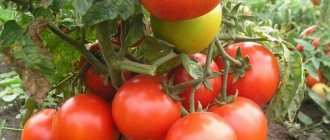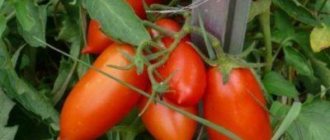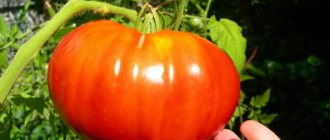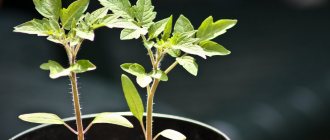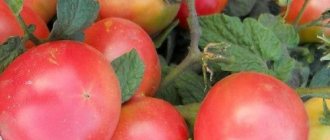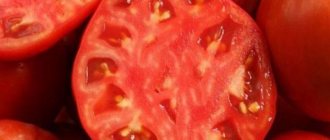Many farmers like to grow tomato crops that can bear fruit for a long time. For this reason, an increasing number of gardeners are choosing proven indeterminate varieties. These include Exhibition tomatoes, which have established themselves as a reliable variety.
In fact, the features of the Exhibition tomato variety have made it popular and in demand. With this type of crop, you don’t have to worry about the harvest. By carefully working with the plant, you can get an impressive amount of fruits, characterized by a pleasant taste and overall high quality.
Description
Refers to early varieties.
The bushes are determinate, usually no more than a meter in height. It has high yields and is recommended for open ground, but can also be grown in a greenhouse. The stem is powerful, medium leafy. The fruits are small in size and their weight varies from 60 to 90 grams. Tomatoes have an excellent taste and aroma inherent to tomatoes. Suitable for both fresh consumption and any preservation. The fruits are not subject to cracking. Interesting!
Tomato seeds remain viable for 9 years.
Bushes love light and warmth, this must be taken into account when growing. The variety is highly resistant to common diseases. Tolerates temperatures down to +7.
Advantages and disadvantages
A big advantage is considered to be resistance to high moisture and temperature fluctuations. The bushes can develop stably and not get sick even under the scorching sun, unless, of course, the gardener forgets to provide the tomatoes with good watering. This is a productive variety that will allow you to harvest 8-10 kilograms of tomatoes per square meter.
Tomatoes have exhibition and negative characteristics. One of them is poor shelf life. The maximum you can count on is storage for a week. But in general, it is advisable to consume vegetables as soon as they have been harvested.
You don't have to eat tomatoes fresh. Once processed, they can be enjoyed as pastes, juices or thick purees. Many farmers in their reviews emphasize the ability of the fruits of the Vystavochny variety to be an excellent material for homemade adjika. Canning tomatoes is not practiced, as the fruits are large.
Growing seedlings
For seedlings you will need special containers, this can be a wooden box, a plastic container, seedling cassettes and others that are convenient for the gardener, but before sowing they must be disinfected. There should be drainage holes at the bottom.
You will also need special soil for seedlings, or sand mixed with peat in equal quantities; it must be moistened before sowing.
The seeds also undergo treatment in order to disinfect them and improve sowing qualities, as well as reduce the time before emergence; they are heated at variable temperatures: for 48 hours at +30 degrees and another 72 hours at +50 degrees.
The planting should not be thickened, as this will cause the seedlings to stretch out. Before starting sowing work, the following conditions must be ensured:
- Suitable temperature.
- Lighting.
- Air circulation.
Before the first shoots, the temperature in the room where the container with the seeds is located should be approximately +23, after they appear it can be reduced to +15 during the day, + 10 at night, this temperature regime must be maintained for up to 3 days. Afterwards, the optimal temperature for plants is +20 degrees. Frail sprouts should be watered using a sprayer; they should not be overfilled.
Also, before the seedlings are transferred to a permanent place, they are hardened off for 15 days, the first days they are taken out into the air for an hour, and the time spent outside is gradually increased. This is necessary so that the plants quickly adapt to the garden bed (in the greenhouse) and tolerate replanting more easily.
Cossack tomato reviews photo yield – Fishing caravan
Mid-season (closer to mid-late), indeterminate, tall tomato variety. Recommended for growing in a greenhouse.
A bush with large leaves, not spreading, up to 1.8 meters high. Requires tying to the support and pinning. It is best to form a plant with 1-2 stems.
The fruits are collected in long clusters. They are round in shape, smooth, dark cherry in color at maturity, weighing 35-50 grams. The taste is rich, sweet, juicy. These tomatoes are good for fresh consumption, making juices, sauces, and dressings. The fruits are very tender, so when ripe they are not suitable for whole-fruit canning, as the skin bursts.
There are many seeds in the fruit.
Sowing the seeds of this variety of tomatoes for seedlings is carried out 60-65 days before the intended planting in a permanent place. When planting in a greenhouse for 1 sq. meter there are up to 4 plants.
If you have grown Cossack tomatoes, please write what impression this variety made on you. Will you be planting it again? Thank you!
Your reviews of the Cossack tomato and additions to the description will help many gardeners evaluate this variety objectively and decide whether to plant it or not.
Characteristics of the “Kazachka” variety: medium-late, indeterminate variety, medium-sized fruits. A bush of this variety grows up to 1.8 - 1.9 m high, so it definitely requires gartering to a vertical or horizontal support.
The Cossack tomato variety has a flexible, curly stem. The formation of the stem of these tomatoes is carried out as the plant grows into 2-3 trunks. The leaves of the seedlings are light, and when the plant gains growth, they become dark green and have a regular shape. For 1 sq. m plant up to 4 plants.
Description of fruits
The plant is tall, so “Kazachka” tomatoes are planted using the 50 x 50 cm technology. The period from seed germination to the ripening of the first tomato harvest is 120-125 days.
The description of the “Cossack” fruits is as follows: medium, round or slightly barrel-shaped, smooth, juicy. The color of the ripe fruit is dark, red-brown. The skin of this tomato variety is tender and thin. Tomato variety "Kazachka" has a good delicate taste and pleasant aroma.
Kazachka tomatoes are medium-late ripening. This variety is of indeterminate type; its bushes reach 1.9 m in height. The stems of the plant are flexible and climbing. Usually the bush is formed in such a way that it has no more than three trunks. The leaves at the beginning of the plant's life are light in color, but as they grow they become dark green. The leaf shape is normal. An average of 1.5 to 2.5 kilograms of fruit is harvested from one bush.
Kazakhstan yellow tomato - description and characteristics of the variety
An early, determinate, very productive tomato variety for open ground.
The bush is up to 50 cm high and does not require pinching. A garter to the support is required, as otherwise the plant will fall under the weight of the tomatoes.
photo by Valentina Redko
Super productive variety!
Description of fruits
They are consumed fresh and in salads. The fruits are often preserved in the form of tomato juice, since the very thin skin bursts when the whole fruit is preserved. Reviews for this variety are mostly positive. Those who have already planted tomatoes of this variety note the beautiful appearance of chocolate tomatoes on the bush.
READ MORE: Clematis president description - Garden and vegetable garden
The sizes of the fruits of the variety are not the same, from 35 to 50 grams. Productivity is about 1.5-2 kg per bush.
The fruits of Kazachka tomatoes are medium in size. They have a very beautiful red color, sometimes taking on a chocolate-brown or reddish-purple hue. The fruits are round in shape, but may be slightly barrel-shaped. Cossack tomatoes are smooth, highly juicy, and have delicate, thin skin. They have a very pleasant aroma and delicate taste.
Growing seedlings
Before the first shoots, the temperature in the room where the container with the seeds is located should be approximately 23, after they appear it can be reduced to 15 during the day, 10 at night, this temperature regime must be maintained for up to 3 days. Afterwards, the optimal temperature for plants is 20 degrees. Frail sprouts should be watered using a sprayer; they should not be overfilled.
Views of summer residents
Tomatoes of the Kazachka variety have repeatedly been included in the list of the most popular tomatoes grown in greenhouses. Gardeners value it, first of all, for its unique aroma, thin peel, wonderful characteristic sweetish taste and very juicy pulp. Survey respondents emphasize the beauty of both the fruits and the bush of these tomatoes, good resistance to late blight, and a large number of tomatoes in one bunch.
The Kazachka variety is another successful work of Russian breeders. Tomatoes of this variety have an original pleasant taste and smell, and thin skin. The unusual elegant color and glossy shade give the fruits of this variety an attractive presentation. Kazachka tomatoes are excellent for both industrial cultivation and individual farms.
Preparing the landing site
Considering that tomatoes love light and warmth, choose a sunny area. Bushes should not be planted after nightshade crops, as they have common diseases that can be transmitted to plants through the soil. The best precursors for tomatoes are cabbage, cucumbers and legumes.
The land is prepared in the fall, for this purpose it is fertilized with manure and dug up. This can be done in the spring, but no later than two weeks before planting the seedlings. Fertilizers are also added to the holes; wood ash is perfect. Up to 8 bushes can be placed on one square meter, the planting pattern is 30 by 70.
Tomato Summer resident
Diseases and pests
Careful care and weed control will eliminate the risk of developing serious diseases. Gardeners growing the Exhibition variety do not have to worry about late blight and blackleg, which does not threaten the plant due to good immunity.
In terms of pests, it is always useful to use wood ash or a solution of potassium permanganate, which allows you to control and prevent infestation. An excellent solution would be to use a pesticide if the bushes are negatively affected by insects.
Growing and care
Further care consists of regular watering 1-2 times a week; it is better to choose evening time or cloudy weather for this. When fertilizing with mineral and organic fertilizers, the first can be done 15 days after transplantation, subsequent ones with a break of a month.
Every 10 days it is recommended to loosen the rows and hill up the bushes after each watering.
It is necessary to pull out the weed as it grows so that it does not draw nutrients from the soil. The variety does not require pinching and installation of supports, but some gardeners still do this.
Tomato Kazachka: reviews, photos and features of the variety
| Ripening period: | mid-late |
| Shape, weight of fruits: | round or barrel-shaped, 35-50 g |
| Bush type: | indeterminate |
| Growing regions: | all Russia |
| Productivity: | 8-10 kg per sq. m |
The Kazachka tomato is an interesting variety, the distinctive feature of which is the raspberry-chocolate color of the fruit. Well-developed clusters of tomatoes, covered with shiny, smooth fruits of a rare shade, delight the eye in the greenhouse. The description of the variety will attract the attention of both beginners and experienced gardeners. To grow a decent harvest, you have to work hard, but the result is worth it.
Kazachka tomatoes are a new product from agro. Tomatoes are recommended for growing in greenhouses, where their height reaches 1.9-2 m.
The variety is medium-late, the period from germination to the beginning of fruit ripening is 120-130 days. Growing in open ground is possible only in the southern regions of the country.
The stem of the plant is weak, twisted, and needs to be tied to a trellis from the moment the seedlings are planted in the ground.
The foliage is large, light green, darkening with age. The clusters are long, in the form of braids, each bearing 9-13 fruits.
Kazachka tomatoes are interesting for their color, which, depending on the growing conditions, varies from dark cherry to terracotta (see photo).
Tomatoes have thin skin and juicy, sugary pulp. Characterized by the absence of white veins. The variety is primarily used for salad purposes; when canned, the delicate skin of the fruit may burst. The culture is perfect for making tomato juice.
The Cossack tomato is not particularly resistant to diseases. Soil and planting material must be disinfected. The soil for planting is spilled with a solution of phytosporin or heated in an oven at 100˚C for half an hour.
The seeds are soaked in a solution of cherry potassium permanganate, then washed. To improve immunity, wet seeds can be placed in the refrigerator for a day.
Seeds for seedlings are planted 2 months before planting in the greenhouse. In the middle zone this is the end of February - beginning of March.
Sowing is carried out in shallow boxes to a depth of 1-1.5 cm, and the plantings are covered with film. Maintain air temperature 20-22˚C.
When the seedlings sprout, the box with seedlings is placed in the brightest but coolest place possible; young seedlings tend to stretch out. It’s a good idea to provide artificial lighting.
Seedlings dive in the phase of two true leaves into separate pots. Feed 2 times with special fertilizers for seedlings. Two weeks before planting, the seedlings begin to harden. First, they open the window, then take it out onto the terrace or balcony. Seedlings in pots should spend the last few days in a greenhouse to make it easier to acclimatize.
Depending on the weather, the Cossack tomato is planted in a greenhouse from the end of April to May 10. The soil temperature should warm up to 12-15˚C. On the eve of planting, seedlings are watered abundantly and the lower leaves are cut off.
Plants are planted in prepared holes according to the 50×50 pattern. For 1 sq. m you can plant no more than four bushes. The seedlings are watered abundantly and tied to a trellis. After planting, tomatoes are kept without watering for 7-10 days to form an extensive root system.
The Kazachka variety needs pinching and bush formation. The plant needs to be formed into 2 stems, the second shoot is made from the strongest stepson.
During flowering, the bushes are sprayed with the preparations “Ovary”, “Bud”, and a 2% solution of boric acid. This procedure increases fruit set and improves their sugar content.
READ MORE: Bananas for weight loss: what are the benefits and is it possible to eat bananas for weight loss
The Cossack tomato is responsive to fertilization. At the beginning of the growing season, the crop is fertilized with a solution of organic fertilizers or herbal infusion. During the fruiting period, plants need mineral phosphorus-potassium fertilizers. In August, feeding continues, reducing the dose of nutrients.
Covering the soil with mulch solves several problems at once: it balances the microclimate in the greenhouse, retards the growth of weeds, and prevents the development of fungal diseases. Daily ventilation of the greenhouse is useful.
Water the tomatoes rarely, but generously, avoiding the stream of liquid getting on the trunk and leaves of the plant. One bush needs 7-10 liters of warm, settled water. In August, watering is sharply reduced.
Diseases and pests
The Kazachka variety has moderate resistance to tomato diseases.
Main fungal and bacterial diseases:
- Late blight - appears at the end of summer after cold nights, leaves and fruits are affected. Often has a lightning-fast course. Without taking measures, you can lose your harvest.
- Brown spot is a fungal disease that affects foliage and causes the ovaries to fall off. Reduces yield by a third.
- Alternaria - pathogenic microflora is activated in cold weather and high humidity. The plant dies, losses can reach 65%.
- Blossom rot is a physiological disease caused by negative environmental conditions. Affected fruits are not suitable for use.
For small foci of the disease, folk remedies are used. For extensive lesions, treatment with fungicides is required at least 14 days before harvest.
- thorough cleaning of plant residues from the beds in the fall;
- soil disinfection in the greenhouse;
- planting green manure after harvesting tomatoes;
- spraying young plants with a 1% solution of Bordeaux mixture at the beginning of the season.
Spraying plants with the biological preparation Fitosporin throughout the growing season will protect the crop from diseases, improve the soil structure and its fertility.
The main insect pests of tomatoes:
- whitefly;
- various types of aphids;
- spider mite;
- Colorado beetle.
A small number of parasites are caught using traps and sprayed with aqueous infusions of garlic, onion peels, and tobacco dust. To make the solution stick to the leaves, add diluted laundry or green soap. In advanced cases, systemic and contact insecticides are used: Prestige, Aktara, Fufanon, Actellik.
Similar varieties
The Cossack tomato is a tomato containing the pigment anthocyanin and a high amount of lycopene. These organic substances have antioxidant properties, antitumor effects, and slow down the aging of the body. Unfortunately, black-fruited tomatoes rarely have high yields. The Cossack tomato is one of the pleasant exceptions.
Similar varieties according to characteristics and descriptions:
- Black truffle is a mid-early cultivar, plant height 1.5-2 m, pear-shaped fruits 120-150 g;
- De Barao black - medium late tomato, height 2.4-3 m, round fruits 40-70 g;
- Kumato is a mid-late variety, 2 m tall, fruits 60-80 g.
The Cossack tomato combines the taste of red fruits and the beneficial properties of black-fruited varieties.
Positive qualities of tomatoes:
- pleasant taste and aroma, thin skin;
- increased content of valuable vitamins and microelements;
- attractive color of ripe fruit;
- good set, high yield;
- extended fruiting.
- long ripening;
- when harvested in the technical ripeness phase, sugar content is lost;
- the variety does not tolerate changes in temperature and humidity;
- short shelf life of tomatoes.
The variety is considered one of the best for growing in greenhouse conditions in central Russia.
The advantages of tomato make it attractive for growing in any region of Russia. The Kazachka variety deserves a place in the collection of every gardener who is interested in growing tomatoes.
Sowing seeds, caring for seedlings
As soon as the preparatory measures have been carried out, you can begin sowing the seeds. To do this, the containers must be filled with prepared soil, watered, seeds laid out, and lightly sprinkled with soil.
Note! Do not sow seeds close to each other. As a result, the seedlings will stretch out.
You may be interested in: Dates for planting tomato seedlings in open ground and greenhouses according to the garden calendar Favorable days for planting tomatoes for seedlings in 2021 according to the lunar sowing calendar Favorable days for picking tomatoes in 2021 after germination: timing of picking tomato seedlings in the table by day
To get strong seedlings, you need to properly care for them. The main care measures are as follows:
- Temperature. It is important to maintain the temperature within 23 degrees.
- Watering. Seedlings need to be watered using a spray bottle.
- Hardening. Before planting seedlings in the ground, the plants should be prepared. For this purpose, it is necessary to carry out hardening. The procedure is to daily increase the time the seedlings spend outside. This will allow the plants to get used to outdoor conditions.
Characteristics of the variety
The bushes are compact, reaching a height of 70 cm. The variety is early ripening. The fruits are presented in red, each size is approximately 80 grams. The variety is considered high-yielding, suitable for cultivation in protected and open ground.
Note! The Kazatsky variety is one of the earliest.
